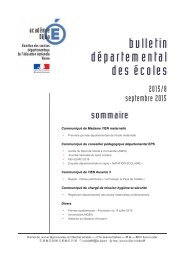agrl_innovations_in_ssa.pdf?utm_content=buffercb41d&utm_medium=social&utm_source=twitter
agrl_innovations_in_ssa.pdf?utm_content=buffercb41d&utm_medium=social&utm_source=twitter
agrl_innovations_in_ssa.pdf?utm_content=buffercb41d&utm_medium=social&utm_source=twitter
Create successful ePaper yourself
Turn your PDF publications into a flip-book with our unique Google optimized e-Paper software.
A comparative analysis<br />
of the case studies<br />
Contrast<strong>in</strong>g cases<br />
The case studies offer a series of contrasts <strong>in</strong>clud<strong>in</strong>g different commodities, operational levels<br />
at national or district level, and success drivers, <strong>in</strong>stitutional, technical or policy <strong><strong>in</strong>novations</strong>.<br />
At the same time comparisons have been possible between planned or opportunity-driven<br />
<strong>in</strong>novation and the stage reached, be this at <strong>in</strong>itiation, or assessment, or achieved susta<strong>in</strong>ability.<br />
Other contrasts <strong>in</strong>clude the challenges and opportunities addressed; i.e., how stakeholders<br />
have <strong>in</strong>teracted to stimulate <strong>in</strong>novation. This has allowed success factors and key lessons to<br />
be identified.<br />
The case studies were broadly classified <strong>in</strong>to five development groups, (Table 2 <strong>in</strong> the second<br />
section). These <strong>in</strong>cluded successful <strong>in</strong>novation based on:<br />
1. Traditional crops – ca<strong>ssa</strong>va <strong>in</strong> Ghana and Nigeria, legumes (<strong>in</strong>clud<strong>in</strong>g seed, climb<strong>in</strong>g beans<br />
and groundnuts) <strong>in</strong> Malawi and Rwanda, and vegetables <strong>in</strong> Niger.<br />
2. Export cops – bananas <strong>in</strong> Cameroon, cotton <strong>in</strong> Malawi, horticulture <strong>in</strong> Kenya, p<strong>in</strong>eapples<br />
<strong>in</strong> Ghana.<br />
3. Niche crops – Sidama coffee <strong>in</strong> Ethiopia and garlic <strong>in</strong> Cameroon, both also export crops.<br />
4. Livestock – beef <strong>in</strong> Botswana and dairy<strong>in</strong>g <strong>in</strong> Kenya and Uganda.<br />
5. NRM <strong>in</strong> Malawi and Zambia for both staple and export crops.<br />
Scale, type and phase of the <strong>in</strong>novation process<br />
Of the 21 cases, 12 were <strong>in</strong>stigated at national and 9 at district or local government level, 13 were<br />
planned and led by the public sector, while 9 were opportunistic, with the private sector or NGOs<br />
tak<strong>in</strong>g the lead. 11 cases have reached a stage where susta<strong>in</strong>ability has or is be<strong>in</strong>g reached, while<br />
the rema<strong>in</strong><strong>in</strong>g 10 are <strong>in</strong> the latter stages of learn<strong>in</strong>g and assess<strong>in</strong>g from the process.<br />
Challenges and opportunities<br />
Each case study experienced a wide range of challenges with which it was faced before the<br />
<strong>in</strong>novation process was triggered. These have been grouped under six broad categories: policy;<br />
<strong>in</strong>frastructure; <strong>in</strong>stitutions; markets; support services; and farm<strong>in</strong>g systems. Policy challenges<br />
<strong>in</strong>cluded both lack of, or poor policy and regulation. Poor <strong>in</strong>frastructural development <strong>in</strong>cludes<br />
82 Agricultural Innovation <strong>in</strong> Sub-Saharan Africa






